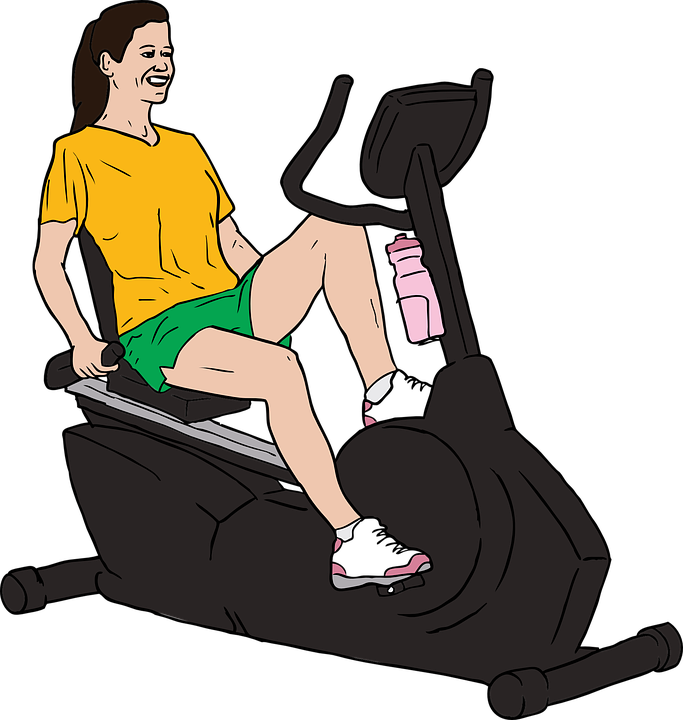Exercise-induced hypoalgesia is a reduction in pain that occurs during or following a single bout of exercise (Naugle et al, 2012).
When researchers test exercise-induced hypoalgesia, they briefly induce painful stimuli to research participants to see if pain sensitivity changes after exercise. Different types of painful stimuli have been used by researchers (e.g. pressure, thermal, electrical), but it is unclear if exercise affects all types of painful stimuli equally.
In our recent study (Jones et al. In Press), pressure pain thresholds, heat pain thresholds, laser evoked potentials and pain intensity ratings to laser stimulation were measured before and after 20 min of moderate intensity cycling and 20 min of very light intensity cycling. Importantly, pressure pain thresholds and heat pain thresholds were measured over a similar area on the lower leg and over a similar time course of 6-10 s.

WHAT DID WE FIND?
We found that exercise increased pressure pain thresholds (i.e. less pain) by 25-30%, whereas heat pain thresholds hardly changed (1-5% increase). Our two other measures of heat pain sensitivity – laser evoked potentials and ratings of laser-pain intensity – did not change after exercise either. These results show that exercise reduces sensitivity to pressure pain more than heat pain in healthy adults.
SIGNIFICANCE AND IMPLICATIONS
It’s difficult to say exactly why exercise reduces sensitivity to pressure pain more than heat pain. Exercise-induced hypoalgesia is present in animals, implying an innate presence of this pain response. From an evolutionary perspective, the ability to ignore pressure pain during exercise would be of importance in a fight or flight situation. In contrast, becoming too desensitised to heat would likely be detrimental given that body temperature must be tightly controlled during exercise to sustain performance and avoid tissue damage (Todd et al, 2005).
From a clinical perspective, experimentally-induced pressure pain is arguably the most similar to the clinical pain experienced by people with chronic musculoskeletal pain. Therefore, the positive effect of acute exercise on pressure pain may be of clinical importance. We cannot conclude this from our study because we only tested pain-free adults, but previous studies have shown exercise reduces sensitivity to pressure pain in adults with chronic pain (Burrows et al, 2014).
PUBLICATION REFERENCE
Jones, MD., Nuzzo, JL., Taylor, JL. Barry, BK (2018). Aerobic exercise reduces pressure more than heat pain sensitivity in healthy adults. Pain Med. In Press.
If you cannot access the paper, please click here to request a copy.KEY REFERENCES
Burrows NJ, Booth J, Sturneiks D, Barry BK. Acute resistance exercise and pressure pain sensitivity in knee osteoathritis: A randomised crossover trial. Osteoarthritis Cartilage 22: 407-414, 2014.
Naugle, KM, Fillingim, RB, Riley JL 3rd. A meta-analytic review of the hypoalgesic effects of exercise. J Pain 13: 1139-1150, 2012.
Todd G, Butler JE, Taylor JL, Gandevia SC. Hyperthermia: a failure of the motor cortex and the muscle. J Physiol 563: 621-631, 2005.
AUTHOR BIO
Matt Jones is an Accredited Exercise Physiologist and an Associate Lecturer at UNSW in the Department of Exercise Physiology. He also holds an honorary appointment at Neuroscience Research Australia. Matt’s research focuses on the role of exercise in the management of chronic pain and fatigue. Click here to read Matt’s other blogs. He can be followed on Twitter @Mattjones0203.

Could you send me a reprint?
Hi David,
In most of our blogs, including this one, you will see a sentence under the Publication Reference that says: “If you cannot access the paper, please click here to request a copy.” When you click “click here,” this sends us an email indicating you would like a copy of the paper.
I hope this helps.
Sincerely,
MI Blog